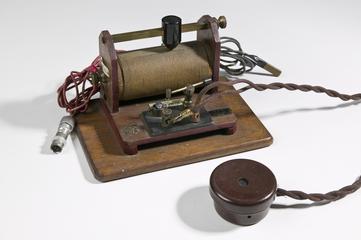Typex Mk III Exp ciphering machine, complete in fibre transit case, c. 1945. Electrical impulses were transmitted through 5 drums or wheels, arranged in a pre-determined order. A message was typed with the left hand whilst turning the handle with the right, achieving 20 words a minute. Cypher, or plain text, was printed onto paper tape, to be transcribed into a communication system.
The British Typex cypher machine was based on the German Enigma cipher machine. In 1928 the British government bought two commercial Enigmas and commissioned Creed & Company to manufacture an Enigma-type cipher machine.
By 1936, they had produced an electro-mechanical cypher machine of their own developed in collaboration with the Royal Air Force (RAF) which became known as 'The RAF Enigma with Type X attachments', and subsequently 'Typex'. Only a few Typex machines were built before British code-breakers began to break the Enigma cipher. Britain used its understanding of Enigma to further defend TYPEX against German attack.
German code-breakers believed Typex encryption to be similar to their own Enigma ciphers and therefore ‘unbreakable’, and so did not make serious efforts to attack it. It is thought that the Germans were unable to read messages encrypted by Typex and that the Typex cipher machine remained unbroken during the Second World War. As of 2021, some aspects of the Typex cipher machine design remain classified. This Typex machine was donated to Science Museum collections by the UK's Government Communications Headquarters (GCHQ).


















